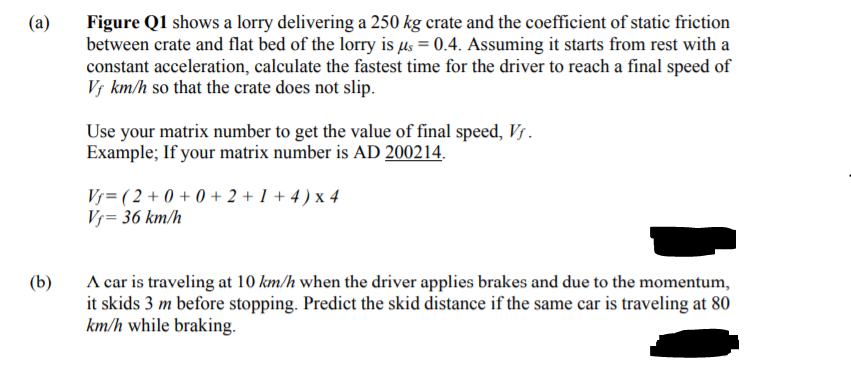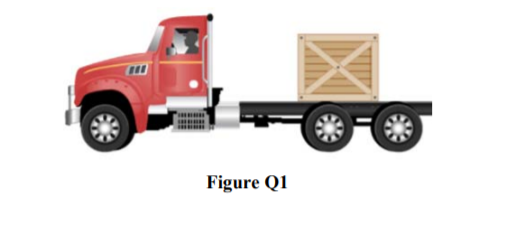(a) Figure Ql shows a lorry delivering a 250 kg crate and the coefficient of static friction between crate and flat bed of the lorry is µs = 0.4. Assuming it starts from rest with a constant acceleration, calculate the fastest time for the driver to reach a final speed of Vs km/h so that the crate does not slip. Use your matrix number to get the value of final speed, Vs. Example; If your matrix number is AD 200214. Vs = ( 2 + 0 + 0 + 2 + 1 + 4 ) x 4 Vs= 36 km/h A car is traveling at 10 km/h when the driver applies brakes and due to the momentum, it skids 3 m before stopping. Predict the skid distance if the same car is traveling at 80 km/h while braking. (b)
(a) Figure Ql shows a lorry delivering a 250 kg crate and the coefficient of static friction between crate and flat bed of the lorry is µs = 0.4. Assuming it starts from rest with a constant acceleration, calculate the fastest time for the driver to reach a final speed of Vs km/h so that the crate does not slip. Use your matrix number to get the value of final speed, Vs. Example; If your matrix number is AD 200214. Vs = ( 2 + 0 + 0 + 2 + 1 + 4 ) x 4 Vs= 36 km/h A car is traveling at 10 km/h when the driver applies brakes and due to the momentum, it skids 3 m before stopping. Predict the skid distance if the same car is traveling at 80 km/h while braking. (b)
Elements Of Electromagnetics
7th Edition
ISBN:9780190698614
Author:Sadiku, Matthew N. O.
Publisher:Sadiku, Matthew N. O.
ChapterMA: Math Assessment
Section: Chapter Questions
Problem 1.1MA
Related questions
Question
100%
USE this matrix num
ad 200153

Transcribed Image Text:(a)
Figure Q1 shows a lorry delivering a 250 kg crate and the coefficient of static friction
between crate and flat bed of the lorry is µs = 0.4. Assuming it starts from rest with a
constant acceleration, calculate the fastest time for the driver to reach a final speed of
Vs km/h so that the crate does not slip.
Use your matrix number to get the value of final speed, Vs.
Example; If your matrix number is AD 200214.
Vj= ( 2 + 0 + 0 + 2 + 1 + 4 ) x 4
Vj= 36 km/h
A car is traveling at 10 km/h when the driver applies brakes and due to the momentum,
it skids 3 m before stopping. Predict the skid distance if the same car is traveling at 80
km/h while braking.
(b)

Transcribed Image Text:Figure Q1
Expert Solution
This question has been solved!
Explore an expertly crafted, step-by-step solution for a thorough understanding of key concepts.
Step by step
Solved in 6 steps with 8 images

Knowledge Booster
Learn more about
Need a deep-dive on the concept behind this application? Look no further. Learn more about this topic, mechanical-engineering and related others by exploring similar questions and additional content below.Recommended textbooks for you

Elements Of Electromagnetics
Mechanical Engineering
ISBN:
9780190698614
Author:
Sadiku, Matthew N. O.
Publisher:
Oxford University Press

Mechanics of Materials (10th Edition)
Mechanical Engineering
ISBN:
9780134319650
Author:
Russell C. Hibbeler
Publisher:
PEARSON

Thermodynamics: An Engineering Approach
Mechanical Engineering
ISBN:
9781259822674
Author:
Yunus A. Cengel Dr., Michael A. Boles
Publisher:
McGraw-Hill Education

Elements Of Electromagnetics
Mechanical Engineering
ISBN:
9780190698614
Author:
Sadiku, Matthew N. O.
Publisher:
Oxford University Press

Mechanics of Materials (10th Edition)
Mechanical Engineering
ISBN:
9780134319650
Author:
Russell C. Hibbeler
Publisher:
PEARSON

Thermodynamics: An Engineering Approach
Mechanical Engineering
ISBN:
9781259822674
Author:
Yunus A. Cengel Dr., Michael A. Boles
Publisher:
McGraw-Hill Education

Control Systems Engineering
Mechanical Engineering
ISBN:
9781118170519
Author:
Norman S. Nise
Publisher:
WILEY

Mechanics of Materials (MindTap Course List)
Mechanical Engineering
ISBN:
9781337093347
Author:
Barry J. Goodno, James M. Gere
Publisher:
Cengage Learning

Engineering Mechanics: Statics
Mechanical Engineering
ISBN:
9781118807330
Author:
James L. Meriam, L. G. Kraige, J. N. Bolton
Publisher:
WILEY